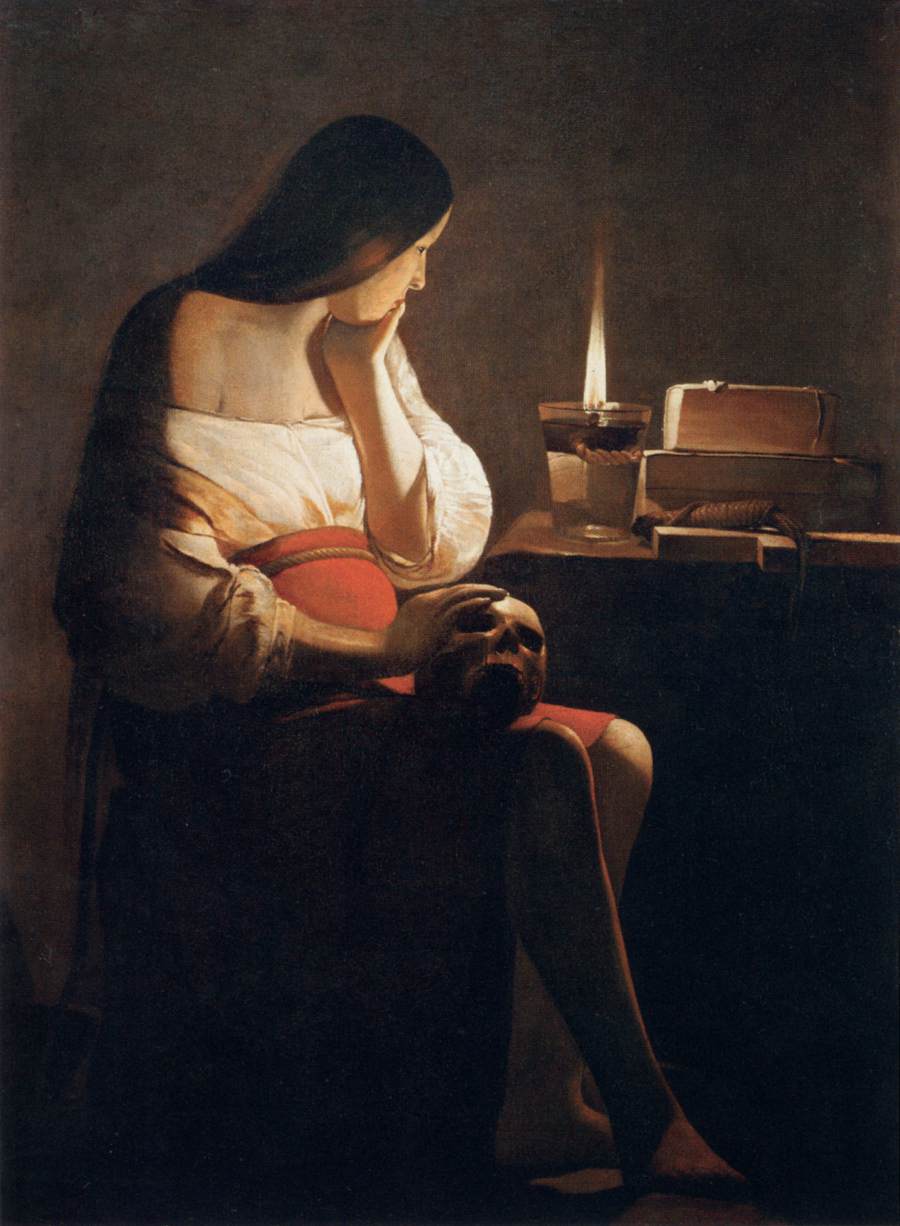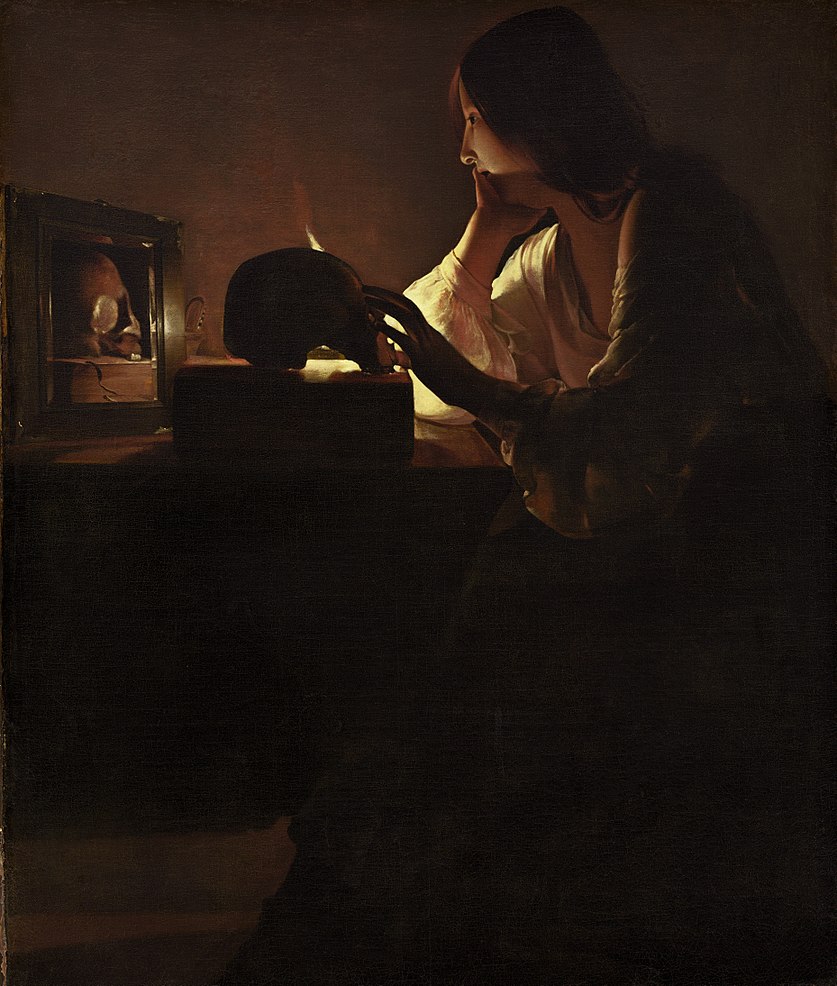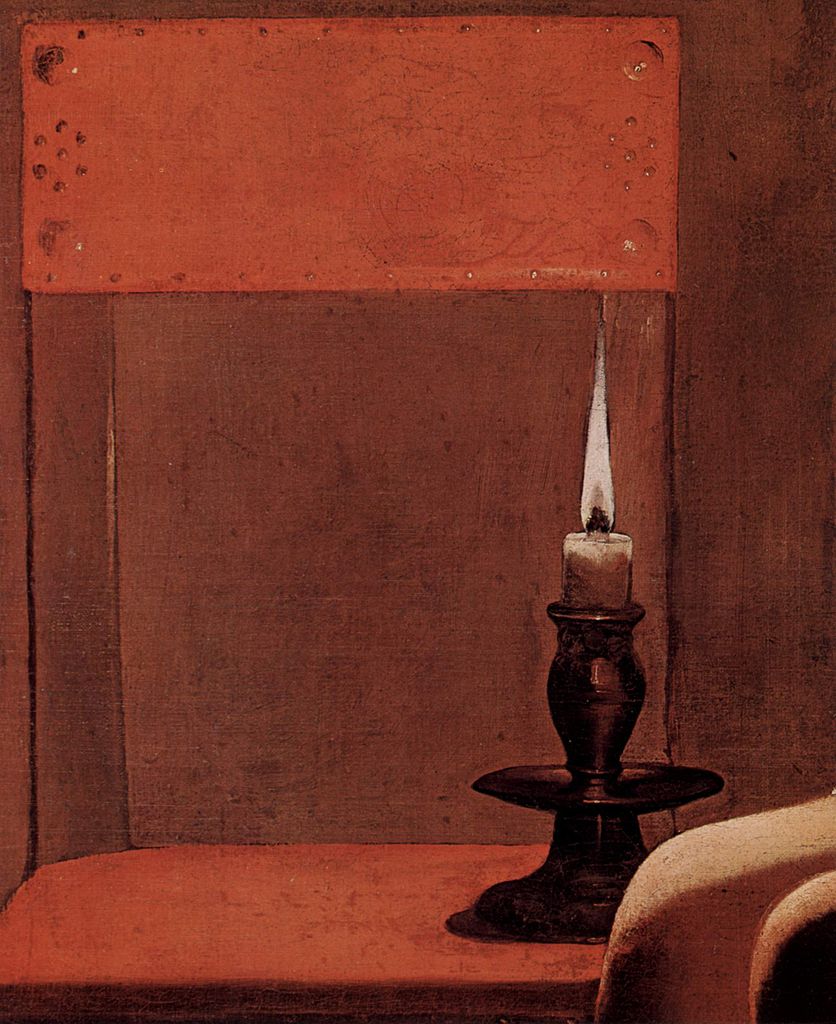.

The Penitent Magdalen ("Magdalen of Night Light"): Georges de La Tour (1593-1652), c. 1640 (Los Angeles County Museum of Art)

The Penitent Magdalen ("Magdalen of Night Light") (detail): Georges de La Tour (1593-1652), c. 1640 (Los Angeles County Museum of Art)
![[09magdam.jpg]](https://blogger.googleusercontent.com/img/b/R29vZ2xl/AVvXsEhXn2Lo8sAdzvVA_rMAnvUJ2hAIe0B1mq3uLC7-oZezUTYN1vYKJUjDs32pEzZG31fiYlLcy-9hR1I8y_evv7imqRAPakzJeWoaMreiShU359q63WTcnxZ8RfIETLrA3s-n03YCY0mSgLdA/s1600/09magdam.jpg)
The Penitent Magdalen ("Magdalen with the Smoking Flame"): Georges de La Tour (1593-1652), 1640-1645 (Musée du Louvre, Paris)
Little Prince basks serene
As an Egyptian god on his barge
On the green cushion, gently breathing
While in his sleep mouselike plays the mind
With its empty toys less real
Than the large drops of rain the nightwind tosses
The night, dark as the flooding of the Nile
The brain, that clouded crystal ball
Blurry with drowned thoughts --
A dream of words, sub noctis
Flowing from magic into error, from aether into terra --
On the upriver stream toward morning
![[10penite.jpg]](https://blogger.googleusercontent.com/img/b/R29vZ2xl/AVvXsEjsIlhjc469zWcoZphjSx6cK9lqQ2TjsmEVgEVydgkBxqqcvyUbOuIaCOL8DfQp7ROKZnRLuxLjcQg4H8msNp4TKNALm-8ipxIn4DpHJeftetYCzkqx1Kz0gH7JTK_mhMosoCQBu93_kSRU/s1600/10penite.jpg)
The Penitent Magdalen ("Magdalen at the Mirror with Two Flames"): Georges de La Tour (1593-1652), 1635-1640 (Wrightsman Collection / Metropolitan Museum of Art, New York)

The Penitent Magdalen ("Magdalen at the Mirror with Two Flames") (detail): Georges de La Tour (1593-1652), 1635-1640 (Wrightsman Collection / Metropolitan Museum of Art, New York)

The Penitent Magdalen at the Mirror ("Fabius Magdalen"): Georges de La Tour (1593-1652), 1635-1640 (Fabius Collection / National Gallery of Art, Washington, D.C.)

Penitent Magdalen [?] ("Woman Catching Fleas"): Georges de La Tour (1593-1652), c. 1635 (Musée Historique Lorrain, Nancy)

Penitent Magdalen [?] ("Woman Catching Fleas") (detail): Georges de La Tour (1593-1652), c. 1635 (Musée Historique Lorrain, Nancy)
[La Tour's] later work discards the rowdy group scene in favour of individual figures who sit alone by candlelight, in states of heightened privacy and inwardness. In one extraordinary case, known as 'The Flea Catcher', a woman, half-undressed, inspects her body for parasites -- in principle, a very low-life subject indeed, but handled by La Tour so as to suggest a quite different kind of process, a sombre self-assessment, an examination of conscience, a renunciation of the world's show. La Tour's various representations of Mary Magdalene rework the nocturne in the direction of self-scrutiny and penitence; the candle sits next to a skull, and it is the skull, not her own beauty, that the saint pensively considers in the mirror. La Tour exploits to the full the capacity of candlelight to spirit away the world that lies outside its own bright centre, and swallow it up in darkness; it is as though nothing exists beyond the figure's own solitude.
-- Norman Bryson



16 comments:
This is tremendous, Tom. Her gaze, as seemingly hollow as that of a skull . . . but, maybe, not quite. The gaze into nothing, or at the body, a kind of something borne of and reduced eventually to nothing -- into & at the mirrors all around.
Brad, the candlelight scenes, with the mirrors particularly, have a way of casting the inessentials into a penumbra of doubt and shadow, with the extraordinary effects of spiritual transformation bestowed by candlelight upon scenes of everyday life creating, in the same moment, a clarity not commonly associated with darkness and nocturnes. Contemplation finds its way in through the skull to the soul. La Tour's ability to use lighting and the meanings of lighting as the basis of his pictures remains astonishing to me, illuminating these unexpected dimensions...
Very much agreed. I'd not seen these before, but find this morning I cannot stop looking. I must learn more.
Yes, these are truly amazing!
Lovely lovely lovely and that last line, wow. I wish I could express this more eloquently, use a big world such as boalicra, but I cannot. I hope it will do.
Very beautiful! As well as the skull has a renown symbolic meaning, what does the candle intends to mean? I'm sure it's a symbolic object, but I'm not sure what does it means here (the enlightenment of faith?) I'll have to research this. Very interesting.
Tom,
"On the upriver stream toward morning"
11.10
light coming into sky above still black
ridge, whiteness of moon next to branch
in foreground, sound of wave in channel
there, nothing more carried
forward by line which
is this, continuing further
toward here, becoming
first orange of sun rising above ridge,
white line of jet trail across from it
Thanks everyone, glad I am not the only one who will never tire of looking at these great paintings.
As you know, Julia, the skull tells us the work falls into that genre of symbolic comment upon the transient nature of human life, and human vanity in particular: Vanitas vanitatum omnia vanitas.
See: Walter Benjamin: Cult.
In practise, the "vanity" genre came to outgrow its moralistic message. In Northern Europe, especially, the presence of the skull in a still-life became an excellent pretext for introducing all sorts of interesting objects, some symbolic, some not.
About the use of candlelight... of course it's the key to everything, here.
With La Tour, the lighting is at once expressive resource, indicator of inwardness and spiritual illumination, and technical device, advancing the art of painting "backward" -- that is, away from the classical Renaissance presentation of a luminous world, where nothing is hidden from view; a world organized according to principles of clear composition, which allow the viewer to grasp the story as economically as possible, and to see the intended harmonies between figures and objects as they unfold across the painting's surface -- and into the murky obscurities of darkness and shadow.
Caravaggio had begun this exploration of the chiaroscuro mode. The raking shadows spread across Europe from Italy to Spain and Zurbarán. Whether La Tour, who came from the North, had seen any of that work, remains in question. It's been speculated he encountered the idea of painting "night-pictures" during a visit to Rome, or to the studios of painters in Utrecht. Or he might simply have stayed home in Lorraine and absorbed the influence of the "tenebroso" style from local painters. In any event he became the great master of the mode. In his later work, nocturnes dominate. His development of the candlelight pictures was remarkable and unique. Not just in the concentration and intensity, but in the radical reorganization of the elements of tenebrist picture-making.
As to my poem, there's a sort of tenebrous element. It was writ late one rainy night about six weeks after 9/11. "Terror"-- when said by New Yorkers -- kept sounding like "Terra" to me, at that time.
And there was the general sense then, of being in the dark.
(Also ever since.)
Little Prince was a true and veritable god, who too soon after the writing of the poem, sailed off on his barge into the eternal shadows.
Gracias, Tom! For the post, of course. And for your wise words here aswell
It is striking that in each of these scenes, death is her intimate, comforting familiar, a kind of touchstone within the pensive moment.
Yes, Annie, it does feel close. The pensiveness, certainly. The reflection, the pondering. But... the comforting... well, one can always hope.
(On the other hand, it is for sure and certain a comfort to be hearing from you.)
You've collected & ordered these variations as a stream of music. Thank you!
Martha, thank you, that's exactly what this was meant to be, something like a stream of music. Of course it helped a lot that La Tour provided the magnificent Variations on a Theme, such a profound source to work with.
This is really superb. And I can't imagine anyone tiring of looking at these paintings or, for that matter, La Tour's work. Curtis
Dear Tom
Just wanted to say that I absolutely love your blog. Incredibly stimulating and surprising every time.
Best wishes,
Gareth
I'd guessed you might feel that way, Curtis; good to hear the guess proved right.
And welcome to you, Gareth. Very much appreciate the kind word. We need all the friends we can get.
Post a Comment